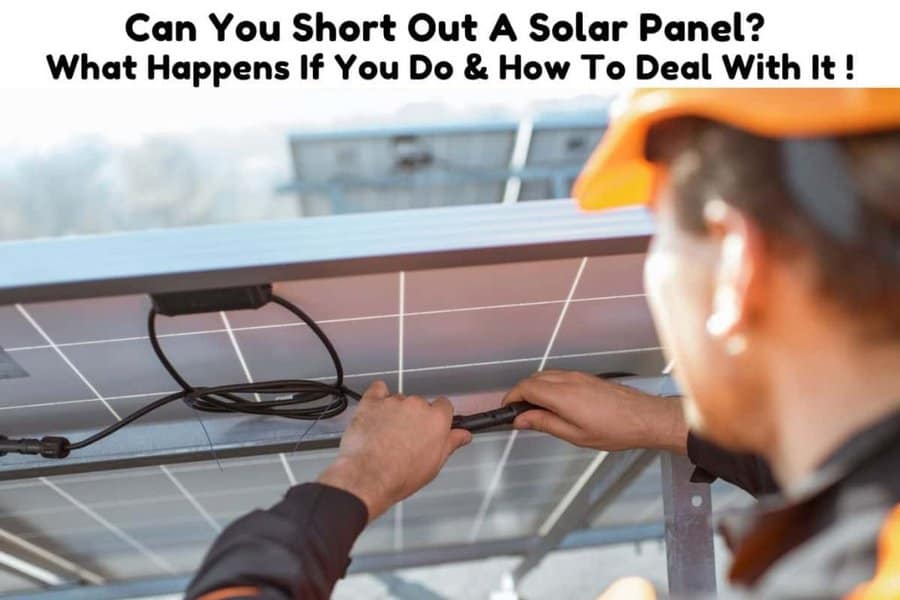Solar panels produce direct current electricity. While a single solar panel will not produce enough current to cause injury, it’s an entirely different story when you are dealing with a large array of multiple solar panels.
There is a high risk of serious injury and it’s important to be aware of and follow the specified safety precautions when dealing with solar panels.
You can short a solar panel, but what happens when you do? To find that out we need to dig into some solar system design basics.

How Is A Solar Cell Short Circuited?
A short circuit in a solar cell can occur in one of two ways. It might happen unintentionally through a fault caused by shading, wear, and tear, damage to cabling, or through the use of unsuitable cabling. A short circuit may also be done intentionally during the testing of a solar panel.
On a side note! If you’re in need of a reliable and high-performance portable solar panel, We strongly recommend the Jackery SolarSaga 100W Portable Solar Panel (Amazon Link).
With a high conversion efficiency and foldable design, this solar panel is easy to transport and set up, making it perfect for outdoor activities like camping, hiking, and RV trips.

The US solar cell technology used in this panel ensures that you get the most efficient and reliable solar charging possible.
There is also a 60W option that is more affordable (Amazon Link)
A short circuit is when an electrical current flows through a shorter unintended path instead of following its set pathway. In other words, it’s when current flows where it’s not supposed to.
Current will flow on the path where there is the least resistance. This is why copper is used for most electrical wiring. It has the least resistance and conducts electricity well. When a short occurs, current has been “detoured” from its normal path in a circuit.
What happens when there is a short circuit?
A short circuit generally will not damage a solar cell. This can happen when part of a solar panel or solar array falls into the shade for example.
What typically happens in a situation like this is the power generation will drop as resistance builds up. This can cause the cell or panel to heat up. This heat can be as high as several hundred degrees and can damage the cell or panel and cause a fire if it goes unchecked. Source
You can also short circuit a solar panel intentionally!
This is a standard diagnostic tool performed to test the maximum current at zero voltage. This is called the short-circuit current of a solar panel and it is one of two tests done to see if the panel is in good working order.
The other test is for the open circuit voltage. How do you test the short circuit current of a solar panel and why is it important?
For more on this, we highly recommend that you check our post ” What Is The Short Circuit Current Of A Solar Panel? What Happens!“
How Do You Test A Solar Panel For A Short?
Testing of the short-circuit current of a solar panel is done with either an ammeter or multimeter. An ammeter or multimeter is a device that gives a measurement of the current and voltage in an electrical component or device.
Before you can proceed to test, you need to check what the short-circuit current of a solar panel is. Along with other values like open circuit voltage and temperature coefficient, this value is given on the back of the solar panel.
How to test with a multimeter
A multimeter is an inline ammeter. Before you start, make sure your multimeter has a fuse bigger than your solar panels’ short circuit current. Using a multimeter these are the steps you would follow to test the short circuit current:
- Switch your multimeter to measure amps.
- Place your solar panel in direct sunlight.
- Touch the positive probe of your multimeter to the positive connector of your solar panel. Touch the negative probe to the negative connector. There might be a few sparks but this is normal.
- The value your multimeter gives you is the short circuit current and should be just about the same as what the back of the solar panel says. In most cases, it will not be exactly the same.
If the value on your multimeter is close to what it says on the specifications then it means your solar panel is working fine. Source
On a side note, check out our post on “Which Solar Panel Connector Is Positive? (Types Listed) “
How to test with a clamp ammeter
With a clamp ammeter, all you do is connect the negative to the positive connector while letting one of the cables pass through the clamp. The ammeter will read the current running through.
Shorting by connecting positive to negative will not damage the solar panel. It can hurt you or damage your equipment if you do not disconnect the conductors properly or if you try to short more than one solar panel at a time.
When testing, make sure to follow specified safety precautions or directions that may be supplied by the solar panel manufacturer.
Can Solar Panels Be Disconnected?
Solar panels can be disconnected from a load. They will still generate energy when disconnected but this energy is not converted to electricity as there is no circuit for the electrons to flow through. What will happen instead is the solar panels will become hotter.
How to disconnect solar panels step by step
It might be necessary to disconnect solar panels for maintenance or moving purposes. In this case, you need to follow certain steps to make sure this is done safely and without damaging your equipment.
- Disconnect them early in the morning or evening. You want there to be as little sunlight as possible. This is the time when they have the lowest voltage or current.
- Turn off DC and AC switch.
- Wear insulated gloves, goggles, and rubber work boots. Depending on the size of the system you’re dealing with you will be handling electrical equipment with high voltage and current. Safety wear will provide you with some protection.
- Cover the solar panels completely with dark opaque material to prevent solar generation.
- Measure the voltage. You want a reading of zero or close to it before you proceed.
- Disconnect the connector of each solar panel and cover the connectors with electrical tape to reduce the risk of electrocution. Source
How Do You Limit The Current Of A Solar Panel?
Solar panel current is regulated through the use of a charge controller and inverter. An inverter converts direct current into alternate current. A charge controller limits the current and voltage going into a battery.
Without a charge controller, solar panels will send all their current into a battery, regardless of how much current that battery can take. This will overcharge and damage the battery.
A charge controller regulates how much current and voltage a battery gets from a solar array as it is charging. There are two types of charge controllers namely PWM or MPPT. Maximum Power Point Tracking (MPPT) charge controllers are more efficient than Pulse Width Modulation (PWM) as they allow you to deliver the maximum amount of energy to a battery. Source
